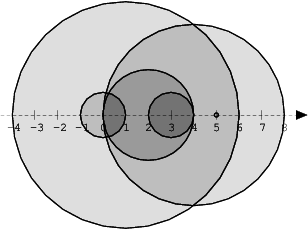Codility Lesson 06
Lesson 6.1 - Distinct
Write a function
class Solution
{
public int solution(int[] A);
}that, given an array A consisting of N integers, returns the number of distinct values in array A.
For example, given array A consisting of six elements such that:
A[0] = 2 A[1] = 1 A[2] = 1
A[3] = 2 A[4] = 3 A[5] = 1the function should return 3, because there are 3 distinct values appearing in array A, namely 1, 2 and 3.
Write an efficient algorithm for the following assumptions:
Nis an integer within the range[0..100,000];- each element of array
Ais an integer within the range[−1,000,000..1,000,000].
Lesson 6.2 - Max Product of Three
A non-empty array A consisting of N integers is given. The product of triplet (P, Q, R) equates to A[P] * A[Q] * A[R] (0 ≤ P < Q < R < N).
For example, array A such that:
A[0] = -3
A[1] = 1
A[2] = 2
A[3] = -2
A[4] = 5
A[5] = 6contains the following example triplets:
(0, 1, 2), product is−3 * 1 * 2 = −6(1, 2, 4), product is1 * 2 * 5 = 10(2, 4, 5), product is2 * 5 * 6 = 60
Your goal is to find the maximal product of any triplet.
Write a function:
class Solution
{
public int solution(int[] A);
}that, given a non-empty array A, returns the value of the maximal product of any triplet.
For example, given array A such that:
A[0] = -3
A[1] = 1
A[2] = 2
A[3] = -2
A[4] = 5
A[5] = 6the function should return 60, as the product of triplet (2, 4, 5) is maximal.
Write an efficient algorithm for the following assumptions:
Nis an integer within the range[3..100,000];- each element of array
Ais an integer within the range[−1,000..1,000].
6.3 - Triangle
An array A consisting of N integers is given. A triplet (P, Q, R) is triangular if 0 ≤ P < Q < R < N and:
A[P] + A[Q] > A[R],
A[Q] + A[R] > A[P],
A[R] + A[P] > A[Q].For example, consider array A such that:
A[0] = 10 A[1] = 2 A[2] = 5
A[3] = 1 A[4] = 8 A[5] = 20Triplet (0, 2, 4) is triangular.
Write a function:
class Solution
{
public int solution(int[] A);
}that, given an array A consisting of N integers, returns 1 if there exists a triangular triplet for this array and returns 0 otherwise.
For example, given array A such that:
A[0] = 10 A[1] = 2 A[2] = 5
A[3] = 1 A[4] = 8 A[5] = 20the function should return 1, as explained above. Given array A such that:
A[0] = 10 A[1] = 50 A[2] = 5
A[3] = 1the function should return 0.
Write an efficient algorithm for the following assumptions:
Nis an integer within the range[0..100,000];- each element of array
Ais an integer within the range[−2,147,483,648..2,147,483,647].
6.4 - Number of Disc Intersections
We draw N discs on a plane. The discs are numbered from 0 to N − 1. An array A of N non-negative integers, specifying the radiuses of the discs, is given. The J-th disc is drawn with its center at (J, 0) and radius A[J].
We say that the J-th disc and K-th disc intersect if J ≠ K and the J-th and K-th discs have at least one common point (assuming that the discs contain their borders).
The figure below shows discs drawn for N = 6 and A as follows:
A[0] = 1
A[1] = 5
A[2] = 2
A[3] = 1
A[4] = 4
A[5] = 0
There are eleven (unordered) pairs of discs that intersect, namely:
- discs
1and4intersect, and both intersect with all the other discs; - disc
2also intersects with discs0and3.
Write a function:
class Solution
{
public int solution(int[] A);
}that, given an array A describing N discs as explained above, returns the number of (unordered) pairs of intersecting discs. The function should return −1 if the number of intersecting pairs exceeds 10,000,000.
Given array A shown above, the function should return 11, as explained above.
Write an efficient algorithm for the following assumptions:
Nis an integer within the range[0..100,000];- each element of array
Ais an integer within the range[0..2,147,483,647].
Comments
Post a Comment